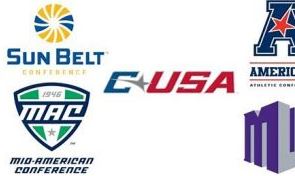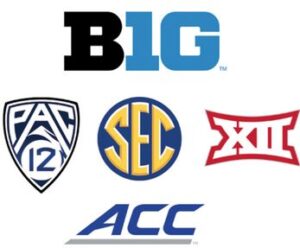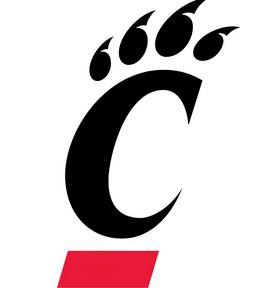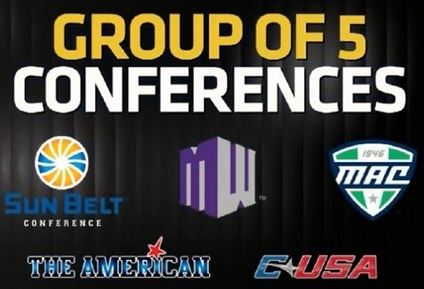Podcast: Play in new window | Download
Subscribe: RSS
According to a 1970’s Steely Dan classic song, the gentleman in the song laments about the depth of his sadness. Feeling like a long-time loser, he uses a sports analogy. “They call Alabama the Crimson Tide, call me Deacon Blues”.

Sadly, Wake Forest University was extremely bad at college football for nearly two decades. From 1960-1978, Wake Forest had just two winning seasons. While Alabama was successful at winning in football during that time, the Demon Deacons were just as proficient at losing.
That song reminds me of how it must feel today to compete in one of college football’s mid-major conferences.
There are five football conferences called mid-majors or, more recently, the “Group of Five”. They are the American Athletic Conference, Conference USA, Mid-American, Mountain West, and Sunbelt.

In 2022, the “Group of Five” had 60 football-playing colleges. They compete in the same top division (called the FBS) as the SEC, Big Ten, ACC, Big 12, and Pac 12. Those conferences are referred to as the “Power Five” for obvious reasons.

Within the current ten conference FBS grouping, the “Power Five” has dominated match-ups with the “Group of Five” much like the Harlem Globetrotters playing against the Washington Generals in basketball. The Generals might win a few games, but it rarely happens.
The mid-major “Group of Five” teams have virtually no chance to win a national championship in the top football division. The FBS champion has been a member of one of the “Power Five” football conferences in every season since the modern day playoffs began in 1989.
Only one team (13-0 Cincinnati of the AAC – ranked #4 in 2021) has been invited to participate in the College Football Playoffs since 1989.

There have now been 86 teams (1989-2022) which have competed in a college football playoff game. Cincinnati’s 2021 team represents a 1.2% (1 of 86) representation rate from the Group of Five mid-major schools in the FBS playoffs.
This System does not work for the Mid-Major Conferences. Why Should they Remain?
The SEC, Big Ten, Big 12, ACC, and the Pac-12 Conferences have the largest television contracts and the largest football stadiums in the country. They have significantly more financial resources available than the mid-major conference teams.
With college football teams now playing a 12-game regular season schedule, many teams have up to four games to fill. The “Power Five” teams will write large checks to smaller football programs (such as the “Group of Five” schools) to play a game at their larger home stadium. Home games for most “Power Five” programs generate several million dollars in revenue.
The visiting “Group of Five” football teams will pocket $1 million or more for making the visit in an early season tune-up game or as the designated homecoming victim.

There is a good reason why “Group of Five” teams do this. Money.
In nearly all cases, a “Group of Five” team will earn significantly more money by going on the road for one of these games than earned by playing a home game with lower net revenue.
The smaller schools utilize the profits earned from these “jackpot” road games to fund the other athletic programs at the university. Most other college sports programs (including basketball or baseball) will operate at a loss.
Most mid-major conference schools know that the odds are quite low that they will have an unbeaten season. That’s about the only way they have a chance to get into the FBS playoffs.

Once a “Group of Five” team loses one or more non-conference road games, they are effectively eliminated from consideration from the lucrative College Football Playoffs.
If that’s not depressing enough, consider this recent change which negatively affects these teams.
The addition of the NCAA’s new transfer portal and legalized payments being made under the new Name, Image, and Likeness (NIL) rules have it even tougher for the “Group of Five” football programs. Their most talented players will be heavily recruited (this time, using NIL cash as an inducement) to transfer immediately into one of the wealthier football programs.
I recently explained this dilemma to one of my sons who graduated from UL-Monroe of the Sunbelt Conference. He said, “You’re saying that our football team will probably be mediocre forever?”

Well, at least for the time being. We’ll get to my solution in just a moment.
FBS: “Let’s Throw These Little Guys a Bone!”

In late 2012, an agreement was reached to guarantee a spot in one of the New Year’s Six bowl games (Peach, Cotton, Sugar, Rose, Orange, and Fiesta) to a team from one of these “Group of Five” conferences. This began with the 2014 football season.
After nine seasons, the Group of Five teams have posted four wins and five losses. In 2022, Tulane (AAC) won an exciting game against USC in the Rose Bowl.

Other recent Mid-Major participants in the bigger payday New Year’s bowls have included:
2021 – Cincinnati (AAC) – College Football Playoffs vs. Alabama – Cotton Bowl (lost)
2020 – Cincinnati (AAC) – Peach Bowl (lost)
2019 – Memphis (AAC) – Cotton Bowl (lost)
2018 – UCF (AAC) – Fiesta Bowl (lost)
2017 – UCF (AAC) – Peach Bowl (won)
2016 – Western Michigan (MAC) – Cotton Bowl (lost)
2015 – Houston (AAC) – Peach Bowl (won)
2014 – Boise State (Mountain West) – Fiesta Bowl (won)
In recent years, the payout going to one of these teams has been more than $5 million. After deducting the expenses of the participating school, the conference of the invited bowl team will share the remaining profits with other conference schools. Every dollar helps!
As you may have noticed, the Sunbelt and Mid-American Conferences have yet to cash-in with a New Year’s Day appearance.
Why would a school want to remain in a Mid-Major Conference any longer?
Of the 131 teams playing football in the FBS (large school division) in 2022, 60 of them (45.8%) play in the Group of Five mid-major conferences. Eleven were in the American (AAC), eleven in Conference USA, 12 from the MAC, 12 in the Mountain West, and 14 in the Sunbelt Conference.
As discussed earlier, only one of those mid-major teams (Cincinnati in 2021) has participated in some form of the football playoffs in 33 years since 1989.
In 2024, a new 12-team College Football Playoff will begin. The field will be comprised of:
(1) Six highest-rated conference champions plus (2) the six highest rated non-champion teams.

The good news for the “Group of Five” is that at least one of its teams will be invited with a corresponding large payday. Of course, the ONE selected mid-major team will likely be ranked #12 (out of 12 teams) in the expanded playoffs. They must slay four Goliaths in order to win the national title.
Good luck with that!
Fact: Many of today’s Mid-Major Teams were National Champions at a Lower Level.
Many of the current 60 mid-major teams were once crowned national champs at the smaller (FCS) level.

Current Sunbelt Conference members like James Madison (2016 and 2004), Appalachian State (2007, 2006, and 2005), Georgia Southern (2000, 1999, 1990, 1989, 1986, and 1985) and UL-Monroe (1987) proudly hang championship banners at their football stadiums.
Conference USA’s Western Kentucky (2002) won a title in the FCS. So did Marshall University. They were a three-time FCS champion (1996, 1995, and 1992). In the Mountain West, Boise State won the FCS title back in 1980.
A few other mid-major teams also won titles at the NCAA Division II level. Current Sunbelt member Troy won the D-II title in 1987 and 1984. MAC competitor Western Michigan won it in 1974. Conference USA member Louisiana Tech scored its lone national title in 1973.
It is time for this group to form another Division and hold their own Championship!

Why don’t the members of the “Group of Five” attempt to form their own division with their own playoff system? The alumni and fans from these schools may like exiting this fruitless pursuit of a national championship against the giants of college football.
Why keep fighting the inevitable?
Are the 60 teams in the “Group of Five” enough to form their own Football Division?
The next lower division is the FCS. In 2022, there were 130 schools playing football in 12 conferences at the FCS level. Those conferences were:
Atlantic Sun (6 teams)
Big Sky (12)
Big South (6)
Colonial Athletic Association (13)
Ivy League (8)
Mid-Eastern Athletic Conference (6)
Missouri Valley (11)
Northeast Conference (8)
Ohio Valley Conference (7)
Patriot League (7)
Pioneer League (11)
Southern Conference (9)
Southland (8)
Southwest Athletic Conference (12)
Western Athletic Conference (6)
Much like the upper division FBS, the smaller school FCS champion has seen its champion primarily coming just a few of its conferences.

The 11-team Missouri Valley Conference has dominated the smaller division in recent years. Winning ten of the past 12 FCS titles, the MVC has been the SEC of this football division.
The 13-team Colonial has been perennially competitive, too. Villanova was the FCS champ in 2009 and the Richmond Spiders won in 2008.

If you elevated those two conferences into a new football league with the 60 mid-majors, a very competitive new football division comprised of 84 teams would be formed.
Let’s call it the FSS!

At least for purposes of this story, the new grouping of the five mid-major conferences and two of the top FCS football conferences will be called the “FSS” (Football SwampSwami – ha, ha).
This new grouping would become part of a new college football organizational structure:
FBS – 71 member schools (ACC, Big Ten, Big 12, Pac-12, and SEC) + Independents
FSS – 84 member schools (American Athletic Conference, Conference USA, Mid-American Conference, Mountain West, and Sunbelt plus the Missouri Valley and Colonial).
FCS – 106 member schools (the current conferences minus the Missouri Valley and Colonial)
The newly created FSS should feature an eight or 16-team football playoff system. Playoffs would begin immediately following the regular system with a winner crowned no later than the first weekend in January.
After decades of irrelevance, it’s time for the “Group of Five” to come alive!

